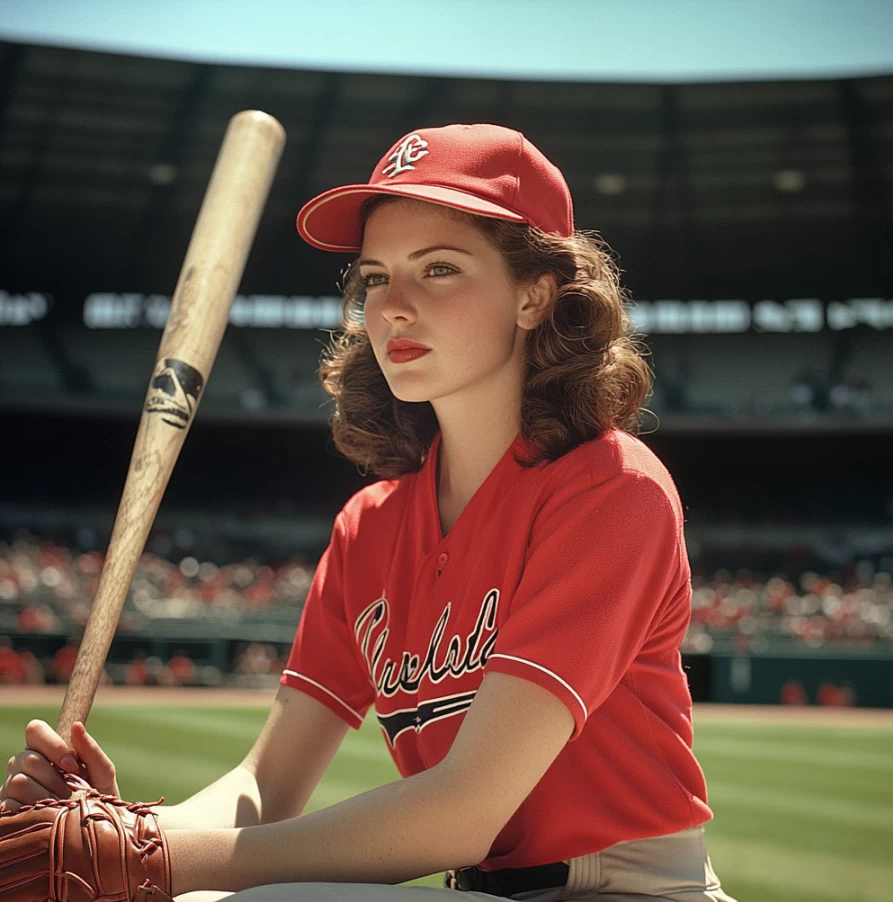Baseball has long been considered the quintessential American pastime, a sport steeped in tradition and dominated by male athletes. For decades, the idea of women stepping onto the diamond was met with skepticism or outright resistance. However, times are changing, and with them, the recognition of women’s contributions to baseball is growing stronger.
In this article, we’ll explore how women have challenged conventions to carve out their place in a sport often seen as off-limits to them. From historical milestones to the modern era, their journey reflects resilience and determination, redefining the notion of who belongs in baseball. By examining key moments, cultural shifts, and ongoing challenges, we can better understand the role women have played—and continue to play—in reshaping this beloved sport.
A Historical Glimpse: Women’s Early Involvement in Baseball
The story of women in baseball stretches back further than many realize. Long before the establishment of organized women’s leagues, women were already making their mark on the sport in unexpected ways. Their participation, though often underappreciated, laid the groundwork for future generations.
The Bloomer Girls and Early Teams
In the late 19th and early 20th centuries, teams like the Bloomer Girls broke barriers by competing against men’s teams. These barnstorming teams featured women players dressed in unconventional uniforms—bloomers instead of traditional skirts—to allow greater freedom of movement. They toured the country, often drawing large crowds and proving that women could compete at a high level.
While they gained some popularity, these teams were viewed more as novelty acts than legitimate athletes. This perception reflected broader societal norms that relegated women to the sidelines in sports and other public spheres.
Alta Weiss: A Female Pitcher Ahead of Her Time
Alta Weiss, one of the standout figures of early women’s baseball, began her career in 1907 as a teenage pitcher for men’s teams in Ohio. Her skill on the mound was undeniable, drawing headlines and spectators wherever she played. Weiss even financed her medical education through her baseball earnings, a testament to both her talent and determination.
Despite her success, Weiss faced challenges that mirrored those of other women in baseball: limited opportunities, societal skepticism, and the constant need to prove her worth. Still, her legacy endures as a symbol of possibility for women in sports.
The All-American Girls Professional Baseball League (AAGPBL): Pioneers in the Spotlight
World War II marked a turning point for women in baseball. With many male players serving overseas, women were given a rare chance to step into the spotlight. The formation of the All-American Girls Professional Baseball League (AAGPBL) in 1943 was a groundbreaking moment in sports history, bringing female players into the professional realm.
Creating the League: Opportunity Meets Necessity
The AAGPBL was established by Chicago Cubs owner Philip K. Wrigley as a way to keep baseball alive during wartime. The league recruited women from across the country, offering them the chance to play professionally while entertaining fans.
Players faced rigorous training, not only in baseball skills but also in deportment, as the league imposed strict rules about femininity. Women were required to wear skirts as part of their uniforms and attend charm school sessions. This dual focus on athleticism and appearance revealed the tension between traditional gender expectations and the groundbreaking nature of the league.
Cultural Impact and Legacy
The AAGPBL lasted until 1954 and became an enduring symbol of what women could achieve in sports. Players like Dottie Kamenshek and Sophie Kurys dazzled fans with their talent, paving the way for future generations of female athletes. The league also inspired the 1992 film A League of Their Own, which brought renewed attention to the AAGPBL’s legacy.
While the league provided an unprecedented platform, its dissolution highlighted ongoing societal resistance to women in professional sports. Nonetheless, the AAGPBL’s impact remains undeniable, proving that women could excel in baseball on a national stage.
From Fans to Players: The Shift in Women’s Roles
As baseball gained prominence as America’s pastime, women were initially relegated to the roles of fans and supporters. Yet over time, they began to challenge these constraints, demanding opportunities to actively participate in the sport they loved. This evolution reflects broader changes in women’s societal roles and the slow dismantling of gender-based barriers.
Joining Local and Amateur Leagues
In the mid-20th century, women’s involvement in baseball expanded through local and amateur leagues. Organizations like the National Girls Baseball League (NGBL) in Chicago provided women with a platform to showcase their skills. Unlike the AAGPBL, these leagues often operated without the same level of media attention but were crucial in keeping women’s baseball alive.
For many players, these leagues served as stepping stones, enabling them to refine their skills and form tight-knit communities of like-minded athletes. Despite limited resources, these teams demonstrated that women’s passion for baseball could not be confined to the sidelines.
Grassroots Efforts and Advocacy
As participation grew, grassroots initiatives began advocating for greater recognition of women in baseball. Parents, coaches, and local organizations championed youth leagues that encouraged girls to play, challenging the stereotype that baseball was exclusively a boys’ sport. This shift not only increased the number of women in the game but also fostered a sense of belonging that transcended traditional gender norms.
In both local leagues and professional settings, women continued to push boundaries, showing that their contributions to baseball were far more significant than many had realized.
Breaking into the Big Leagues: Women in Men’s Baseball
The idea of women working alongside men in professional baseball has long been met with resistance. Yet, over the past few decades, a growing number of women have broken through these barriers to take on significant roles in coaching, scouting, and management. Their presence challenges the long-held perception that baseball is strictly a man’s domain.
As women gain recognition for their expertise, they are proving that their contributions are not only valuable but essential to the sport’s evolution. From the dugout to the front office, their achievements are paving the way for a more inclusive future.
Pioneering Women in Leadership Roles
Several women have emerged as trailblazers in baseball leadership. Kim Ng, for instance, made history in 2020 by becoming the first woman to serve as the general manager of a Major League Baseball (MLB) team. With decades of experience in the league, Ng’s appointment was a milestone, demonstrating that women can excel in high-pressure, decision-making roles.
Other notable figures include Justine Siegal, who became the first woman to coach in the MLB when she served as a guest coach for the Oakland Athletics in 2015. These women have faced skepticism but have consistently proven their competence, opening doors for others to follow.
Challenges of Breaking Barriers
Despite these successes, women in leadership still encounter significant challenges. They often face heightened scrutiny, with their qualifications and decisions questioned more than those of their male counterparts. Additionally, they navigate a workplace culture that has historically excluded them, requiring resilience and confidence to thrive.
To support women in these roles, the baseball community must prioritize mentorship, visibility, and opportunities for advancement. Only by addressing these systemic barriers can true equality be achieved.
Cultural Challenges: Facing Stereotypes and Discrimination
Women in baseball face not only logistical obstacles but also deeply ingrained cultural biases. These challenges are often subtle but pervasive, influencing how women are perceived and treated within the sport. Overcoming these issues requires a cultural shift, both within baseball and in broader society.
Women frequently encounter stereotypes suggesting that they lack the physical ability, knowledge, or experience to succeed in baseball. These attitudes can manifest in exclusion from key opportunities or skepticism about their involvement.
Combating Bias and Stereotypes
To challenge these perceptions, women in baseball have taken several proactive steps:
- Education and Advocacy: Organizations such as Baseball For All promote gender inclusivity by encouraging young girls to participate in the sport. These initiatives aim to dismantle stereotypes and create pathways for women at all levels of baseball.
- Representation in Media: Positive portrayals of women in baseball, whether through interviews, documentaries, or social media, help normalize their presence and highlight their achievements.
Shifting Attitudes Through Visibility
Visibility is a powerful tool for combating discrimination. When young players see women excelling in baseball, they begin to challenge preconceived notions about who belongs in the sport. By celebrating role models and amplifying their voices, the baseball community can foster a more inclusive culture.
Women’s Baseball Today: A Growing Global Movement
While challenges remain, women’s baseball has seen significant growth in recent years. Around the world, more women are participating in the sport than ever before, thanks to increased awareness and support from organizations and communities.
International competitions, grassroots leagues, and advocacy efforts have contributed to this momentum. Women’s baseball is no longer a niche pursuit but a thriving global movement with the potential to inspire future generations.
The Role of International Competitions
Global tournaments like the Women’s Baseball World Cup have become a crucial platform for showcasing female talent. These events draw teams from countries such as Japan, Canada, Australia, and the United States, highlighting the diversity and skill of women in the sport.
Key Organizations Driving Change
Several organizations are dedicated to the growth of women’s baseball:
- Baseball For All: This nonprofit works to create opportunities for girls and women in baseball, organizing tournaments and providing resources for players.
- International Women’s Baseball Center (IWBC): Focused on preserving the history and promoting the future of women’s baseball, the IWBC plays a vital role in advocacy and education.
By supporting these efforts, fans and stakeholders can ensure that women’s baseball continues to flourish.
Representation Matters: Media, Marketing, and Role Models
The way women in baseball are represented in media and marketing significantly influences public perceptions. Positive representation can inspire young athletes, challenge stereotypes, and build a more inclusive baseball culture.
Historically, women’s achievements in baseball have often been overlooked or downplayed. However, recent efforts to amplify their stories are changing this narrative.
The Power of Role Models
Role models play an essential role in encouraging participation and breaking down barriers. Athletes like Malaika Underwood, a veteran of the U.S. Women’s National Baseball Team, and executives like Kim Ng serve as examples of what is possible for women in baseball.
When young girls see individuals who look like them succeeding in baseball, it fosters a sense of belonging and possibility. These role models not only inspire future players but also help shift societal perceptions of women in sports.
Marketing Women’s Baseball
Effective marketing campaigns can elevate women’s baseball by attracting fans, sponsors, and media attention. For example, social media platforms provide a space for women’s teams and leagues to connect with audiences directly, showcasing their talent and building their brand.
By investing in these efforts, the baseball community can ensure that women’s stories and achievements are celebrated and remembered.
Questions and Answers
A: In the 19th century, women participated as players in teams like the Bloomer Girls and worked in supportive roles, often viewed as spectators or enthusiasts. Over time, their roles expanded to include professional opportunities in leagues like the AAGPBL.
A: International competitions like the Women’s Baseball World Cup have provided a platform to showcase talent, foster global connections, and demonstrate the diversity of women in the sport.
A: Representation inspires young athletes, challenges stereotypes, and promotes inclusivity. Seeing successful women in the sport helps normalize their presence and opens doors for future generations.

